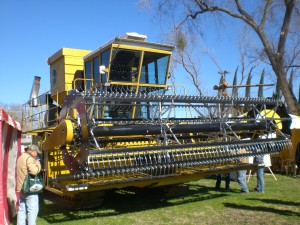Rice harvest is underway! As usual, there’s concern about the weather, but harvest started last month with the early maturing varieties and will continue right into November. It’s fun to see all the videos of rice harvesting rolling onto the internet. Most of those videos are from the Sacramento Valley, where most of the rice in the U.S. is grown. All I have to do is take a little drive to see some live action harvesting, practically in my own backyard.
Rice ranching is one of my favorite equipment appraisal areas, from the high-tech laser-guided grading equipment to the specialized equipment in the California rice mills that mill, sort and package the final product.
When folks talk rice farming this time of year, though, it’s mostly about the harvesters—the combiners that California rice growers have been using since the 1930s.
Of course, combines have evolved quite a bit from those first harvesters pulled by trailers and manned by 2 to 4 people. By the 1950s, self-propelled combines managed by one person were the latest innovation, and in the early 1990s, according to an interesting article over at UC’s California Agriculture, mechanization of rice harvest, combined with earlier-maturing rice varieties, contributed to steadily increasing yields, “from less than 2 tons per acre in the 1940s to 4 tons per acre in 1998, contributing to increased tons of rice harvested per hour.”

This time of year, I don’t get any calls for rice harvest equipment appraisals, but when harvest is over, I know I’ll be back on the road in the Sacramento Valley, doing combine and other rice ranch equipment inspections in Colusa, Butte, Yuba, Glenn, Sutter and Yolo Counties. Did you know, by the way, that commercial production of rice in Butte County started in 1912? It wasn’t long before farmers in other counties discovered that they, too, had the perfect climate and soil for rice.
Jack Young, ASA, CPA
NorCal Valuation




